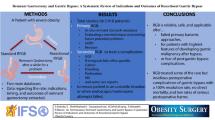Abstract
Background: Since 1992, all patients at our institution who have met standard accepted criteria for surgical intervention for complicated gastroesophageal reflux disease have been entered into a prospective sequential clinical study to evaluate outcomes of the laparoscopic approach to the Nissen-Rosetti procedure and a modified Toupet procedure.
Methods: A standardized workup with upper GI series, esophagography, and endoscopy was used in all patients. Manometry, pH testing, and other special tests were used selectively. A measuring technique was used to determine wrap size without the use of dilators. The short gastric vessels were left intact in all patients. A cosurgeon approach was used, with technical factors described herein.
Results: Some 226 of 231 cases were completed laparoscopically (98%)—125 patients in the Nissen-Rosetti group and 101 in the partial fundoplication group. There were no clinical failures in either group. The partial fundoplication group performed better than the Nissen-Rosetti group in all categories of comparison. Return to normal eating habits was much earlier in the partial wrap group (p < 0.0001). Postop distal esophageal sphincter pressures in the two groups were equal at 15 mmHg. Eight patients suffered significant dysphagia requiring endoscopy and dilatation, all in the Nissen-Rosetti group (p < 0.01). Minor complications occurred in 12% of the total group. There was a total surgical revision rate of 3%. There were no gastric or esophageal perforations. Average operative time was 30 min. Average hospital stay was 1.4 days. Hospital charges for the laparoscopic approach averaged $6,000 dollars compared to $12,000 for the open approach.
Conclusion: Laparoscopic partial fundoplication is as effective as laparoscopic Nissen-Rosetti fundoplication, with a higher satisfaction rate and fewer side effects. Measuring for wrap and hiatus size eliminates the need for and risk of using stiff dilators. By utilizing cosurgeons and currently available technology, cost, operative time, hospital time, and complications can be reduced to a finite minimum.
Similar content being viewed by others
Author information
Authors and Affiliations
Additional information
Received: 12 December 1995/Accepted: 12 August 1996
Rights and permissions
About this article
Cite this article
Coster, D., Bower, W., Wilson, V. et al. Laparoscopic partial fundoplication vs laparoscopic Nissen-Rosetti fundoplication. Surg Endosc 11, 625–631 (1997). https://doi.org/10.1007/s004649900408
Published:
Issue Date:
DOI: https://doi.org/10.1007/s004649900408




